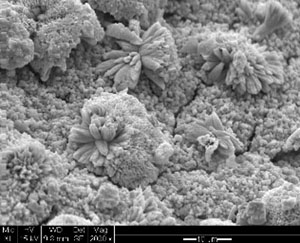
Lead Scale Formation and Solubility
Pb phosphates – A solution or a new problem ?
| A popular strategy for control of Pb release is addition of phosphate, either as orthophosphate, Zn-orthophosphate, or as polyphosphate. Schock et al. (1996) contains a detailed discussion of historic experience with phosphate and of equilibrium modeling. Figure 4 presents a simplified view of phosphate behavior using hydroxypyromorphite as an example. Adding orthophosphate greatly reduces the equilibrium solubility of phases like hydroxypyromorphite and its Cl and F cousins and should therefore reduce Pb at the tap. Similar results are sometimes obtained with polyphosphate addition by utilities with high pH distribution water, possibly because the polyphosphates revert to the monomeric orthophosphate in the distribution system (Schock and Clement, 1998, p. 21). However, in the absence of reversion, polyphosphate may well be detrimental because it prevents the formation of insoluble lead compounds (AwwaRF 1990) or enhances release of Pb particulates (Cantor et al. 2000; Edwards and McNeil, 2002). |  |

Note that the amount of Pb in solution at equilibrium with pyromorphite is appreciably lower than for equilibrium with the carbonates and that the levels approach the LCR limit. However, there is a pronounced solubility minimum and much of the benefit could be lost by raising the pH beyond 8 when using orthophosphates. Chloropyromorphite is appreciably less soluble than hydroxypyromorphite in the MINTEQ database (Hopwood et al., 2002), so the incorporation of even small amounts of Cl- or F- into the structure could change the solubility behavior appreciably. Likewise, the vanadate ion (VO42-) substitutes readily for phosphate, and the mineral vanadinite is known from some distribution systems. Finally, PHREEQC modeling shows strong supersaturation with hydroxyapatite at all levels of orthophosphate addition for the whole pH range in Figure 4. It may be possible that the first phase to form is actually an apatite that subsequently reacts to adsorb Pb from solution. This, however, takes us into the realm of kinetics, which is not well understood for mineral systems in general, and is particularly poorly understood for the time frame and solution conditions presented by distribution systems.